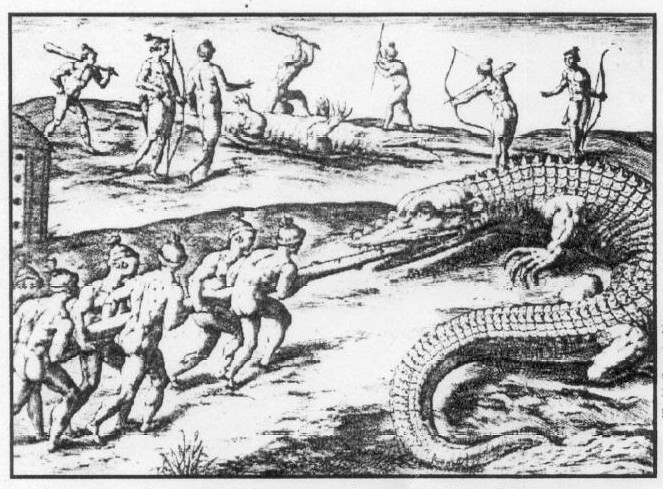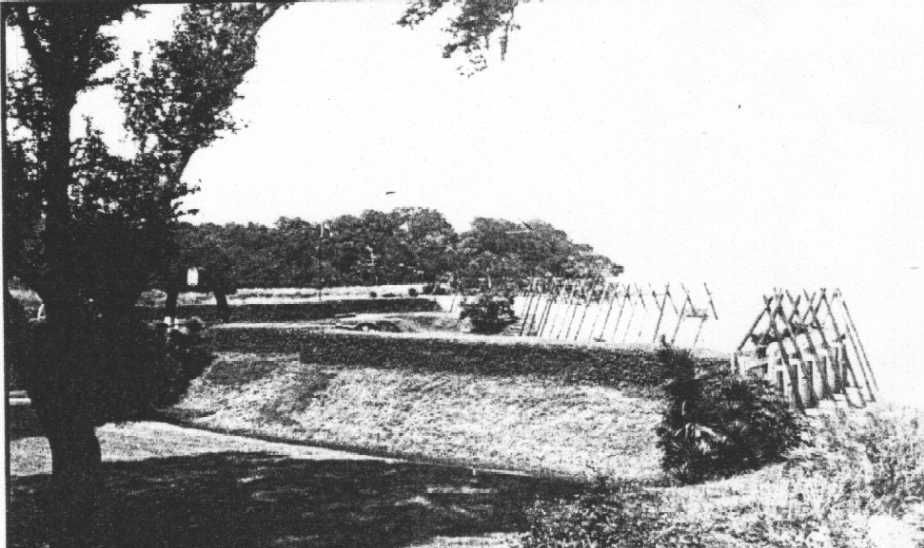
Le Moyne's drawings of the Timuquan Indians were first published in Frankfurt, Germany in 1591.
Historians and historical anthropologists divide the past in chronological
segments. The two
major divisions are the prehistoric and historic eras. The historic era
begins with written recording
of what occurred in human events,. In Florida that time is generally defined
as somewhere between
1513, when Ponce de Leon led the European discovery of Florida, and 1565,
when The Spanish
settlement of St. Augustine was founded.
The historic era is, in turn, divided into five periods, three of them
falling within the colonial
occupation (1565-1821) and two within the post-colonial era. Each is marked
by a decisive change in
the political organization of the peninsula.
First Spanish Period (1565-1764): The longest period yet, this era began
with the founding of St.
Augustine and ended when Spain relinquished ownership of the colony to
England.
British Period (1765-1784): The British divided the peninsula into two
colonies: East Florida,
governed from St. Augustine and reaching to the Apalachicola River; and
West Florida, governed
from Pensacola and including lands west of that river. The British returned
the Floridas to Spain as
a part of the settlement ending the American War of Independence.
Second Spanish Period (1785-1821): A politically enfeebled Spanish Crown,
beset by colonial
insurrection and French invasion in Europe, clung to its Florida colonies
only tenuously. It relinquished
its claims to the United States under the terms of the Adams- Onis Treaty
of 1819.
Territorial Period (1821-1845): Florida remained a territorial possession
of the United States for
twenty-four years, before it gained sufficient population to earn statehood.
Statehood (after 1845): This period is further compartmentalized by historians,
the chronology
depending upon one's historical perspective. Familiar eras they employ
include the Civil War,
Reconstruction, the Great Land Boom of the 1920s, and the Great Depression.

A modern reconstruction of the fort, managed
by the U.S. National Park Service sits near the site of the original settlement.
Ribault brought another company of soldiers and artisans, along with seventy
additional women, to Fort Caroline in 1565. They moved at once to strengthen
defenses, knowing the Spanish would eventually attempt to drive them from
the peninsula. The Spanish had at the same time decided to establish a
position in northeast Florida. Upon receiving reports of the French settlement,
King Philip II ordered his commander, Pedro Menendez, one of Spain's most
able naval officers, to destroy it. In September 1565, Menendez and a large
band of soldiers and colonists landed at what is now St. Augustine, established
a base, and promptly undertook an expedition northward to attack Fort Caroline.
After driving out the French, Menendez garrisoned the fort with Spanish
soldiers and renamed the position San Mateo. In subsequent engagements
at the Matanzas Inlet and Cape Canaveral, Menendez annihilated the French
survivors. A major legacy of the Fort Caroline experience was a set of
drawings of Timuquan Indians made by Jacques Le Moyne, an artist who accompanied
the second expedition. LeMoyne escaped to France before the destruction
of the outpost. He eventually published forty-two drawings that he made
in Florida.
LeMoyne's work provides the earliest account of aboriginal life in
North America and one of the most graphic descriptions of Indians produced
at any point during the North American colonial era.

.............The original plat for Floral Bluff was filed March
1, 1887 by Gilbert Shepard. The plat contained merely four blocks, which
ran east from the landing in the St. John's River along the north edge
of what is today Arlington Road. The principal early nineteenth century
resident of Floral Bluff was Robert Bigelow (1797-1868), a trustee of the
Francis Richard estate, who constructed a large residence on the heights,
overlooking the river. An extensive orange grove surrounded his house,
extending to the water's edge. Bigelow's house and plantation, later called
the Bacon Place, provided the location for many moving pictures filmed
in Jacksonville and Arlington during the short period between 1915 and
1920 when the industry prospered in the two communities. His daughter,
Eugenia Bigelow (1837-1898), taught at the Egleston Heights public school
in 1890. (this must be a twin of Eugene, not previously known..ROD)
........Arlington's Cemeteries: The 1995 historic survey recorded eight
historic cemeteries in Arlington. The origin of three of the cemeteries,
the Sammis Family Cemetery in the Clifton area, The Bigelow Family Cemetery
along Floral Bluff Avenue, and the Parsons Cemetery north of Fort Caroline
Road, date to the pre-Civil War period. Surviving headstones and grave
markers feature the names of many of Arlington's early residents, some
of whom played instrumental roles in the history of Jacksonville and Florida.
The Parson's Cemetery, for example, is the final resting place of Mary
Dorcas Parsons Broward, mother of early twentieth century Florida Governor
Napoleon B. Broward.
continued on jackvil4.htm ...............

